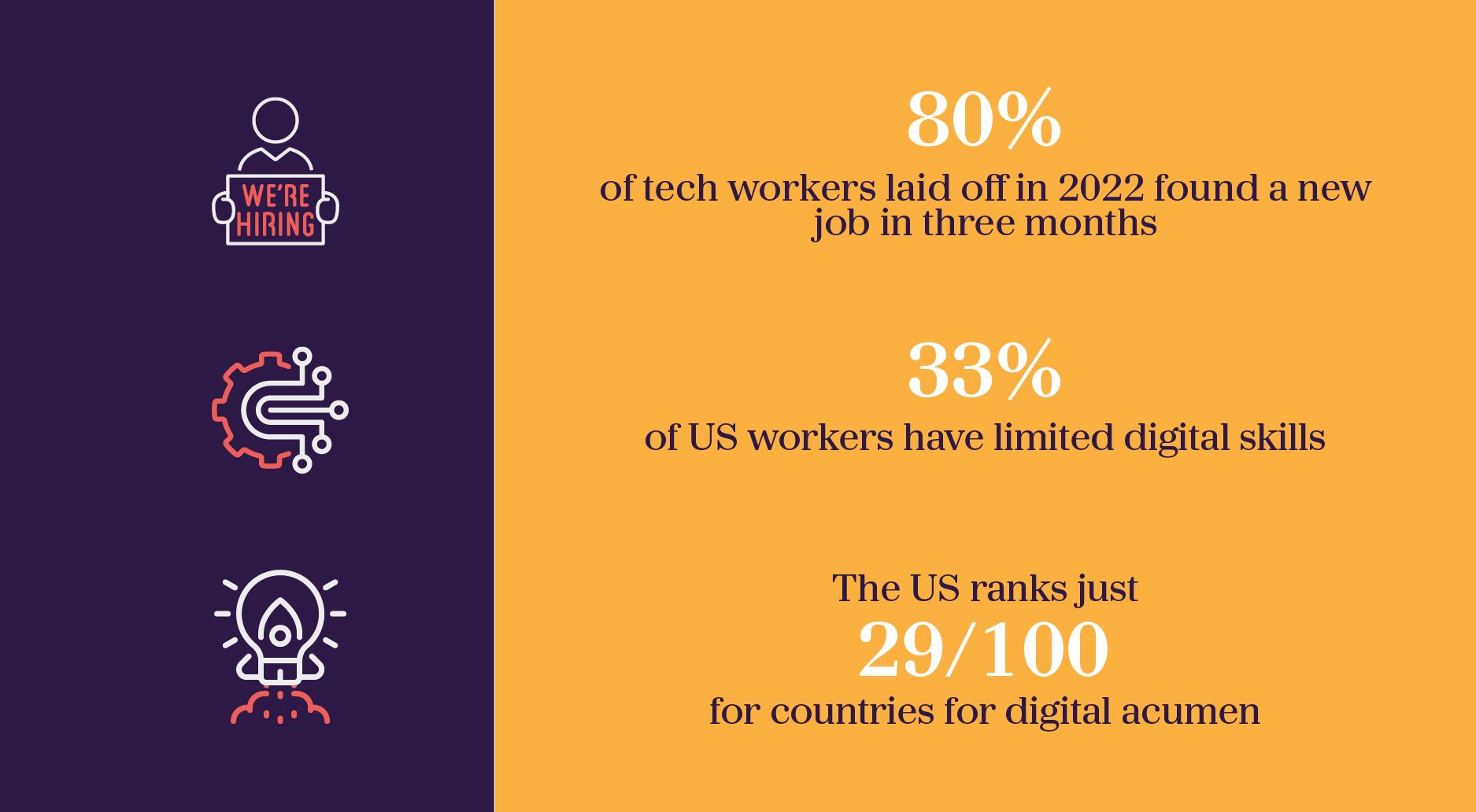Tech skilling and finding the right skills in your organization
Contributors:
David Shrier
Professor of Practice, AI & Innovation, Imperial College Business School
Erica Titchener
Global Head of Technology & Analytics Advisory, AMS
Claudia Nuttgens
Global Head of Assessment Advisory, AMS

Businesses have focused heavily on filling technology jobs in recent years, but the tech talent gap continues to grow - despite recent cutbacks and layoffs.
In fact, around 80% of tech workers who were laid off in 2022 found new jobs within three months, according to a ZipRecruiter survey, with the number of new technology job postings far outnumbering the amount of people laid off. With tech skills in such high demand, many simply moved out of the technology sector into other industries, including retail, fintech and healthcare.
At the same time, research shows that the US is lagging behind its neighbors when it comes to developing digital skills. One third of working age Americans possess ‘limited’ digital skills according to the OECD, with the US ranking just 29 out of 100 countries for the digital acumen of its workforce in business, technology and digital science.
“People are often not thinking in a systems fashion about the impact of digital transformation,” says David Shrier, Professor of Practice, AI & Innovation at Imperial College Business School.
“I spent the summer working with investment bank research house Evercore ISI looking at the impact of AI on the global economy. Their work suggests that almost 100% of jobs will experience some impact from digital transformation, and within that, 32% will feel meaningful effects from AI. We are projecting as much as $11.8tn of GDP growth by 2032 from AI - nearly 10% of global GDP,” he adds.
Dealing with these factors and unlocking the true potential of organizations in a digital age will require a fundamental shift in how companies think about tech talent and skills development. At the heart of this is the move towards skills-based talent management - where employees are hired, rewarded, and developed based on their current and potential skills, rather than past experience or job roles.
Taking a skills approach
Increasingly, organizations are building and developing tech capabilities, rather than simply hiring them.
“Every organization is competing for the same skills. One way to deal with this is internal tech skilling, where you identify existing skills gaps and build out internal training capability to move people from one area of the business into more of a tech space,” says Erica Titchener, Global Head of Technology & Analytics Advisory at AMS.
“The challenges with this are two-fold. First, you need effective internal mobility and learning and development programs. Secondly, you need insight into the existing skills make-up of your organization. That’s the journey most businesses are on - how to identify what skills they already have in the business, and what skills within the business can be transformed, upskilled, or reskilled into the tech space,” she adds.
The idea of a skills strategy is not a new one. However, what is new - as HR thought leader Josh Bersin points out - is the way organizations are using technology and skills frameworks in an integrated way for recruitment, internal mobility and development.
For many businesses, building a skills framework is a messy, incredibly challenging job. Identifying - and then updating - all the skills your people own and that your jobs require is time-consuming and confusing.
“In the past three to four years, technology has really caught up to this skills-based hiring agenda. Instead of building your own internal skills taxonomy, many organizations are using software providers that provide personalizable taxonomies to help drive skills development for employees,” says Titchener.
To succeed in implementing this technology, businesses need to be able to do two things - drive adoption of their chosen platform and accurately assess internal and external skills capabilities.
“To drive adoption, you need colleagues to get something back. You need to think about the user experience and ensure that when they login, it’s always worthwhile. In return for updating their skills, people need to receive opportunities to grow,” says Titchener.

The role of assessment
When it comes to skills-based assessment, some job roles and industries are easier to assess than others, argues Claudia Nuttgens, Global Head of Assessment Advisory at AMS.
“Skills-based assessment works really well in certain areas, particularly technology. Here, you can be prescriptive about the skills needed - such as coding - and what you can predict if you can develop them. If your job is decision-making based and intellectual, it can be harder to quantify the skills needed,” she says.
What skills-based assessment can do is diversify the talent pools you normally recruit or promote from. By focusing on an individual’s capabilities and potential rather than experience and employment history, organizations can tap into new areas. This can be particularly helpful with technology skilling, where potential is easier to map.
“In theory, the skills-based approach will unlock social mobility, gender diversity and internal mobility. You can do a base assessment looking at an individual’s attitude to learning and curiosity while also mapping their past experience to your business needs,” says Nuttgens.
“We’ve seen really good pockets of success in certain role types or demographics, such as our training recruiters program and our work with ex-military personnel - people who wouldn’t traditionally be in those talent pools,” she adds.

Changing business requirements and the impact of technology means the assessment industry is constantly having to update itself. Nuttgens warns that tools like Chat GPT have led to an increase in cheating in assessments, with recruiters having to look at different processes to assess talent. Skills-based hiring is only accelerating this process.
“If you want to move towards skills-based hiring, you can’t just focus on interviewing people and expect to understand their skills. You need to see them work, measure their personalities and attitudes. We’re leaning more towards experiential assessment with a bit more of a human touch,” says Nuttgens.
Diagnose and strategize
With lifelong learning on the agenda for most employees and organizations, it’s also important to focus on so-called softer skills like resilience, agility and adaptability, warns professor Shrier.
“In addition to technical and factual capabilities to address AI disruption and other kinds of digital transformation impacts, companies need to reorient their workforces around the ‘new skills’ of the post-generative AI era: soft skills like empathy, critical thinking, creativity and team skills,” he says.
“One CEO of a $4bn multinational we were working with thought his team were doing quite a bit in this area. It turns out only 20% of training was on soft skills, so doing a diagnostic helped them look at how to reorient their training activities,” adds Shrier.
Ultimately, no technology or desire to focus on skills-based hiring can be successful without planning, processes, and strategizing. Getting skilling right requires a commitment to ongoing development.
“You need to be ready and have the budget to make adaptations and tweaks every quarter. Organizations invest heavily upfront but leave nothing for optimization. Forward planning is key,” says Titchener.
written by the Catalyst Editorial Board
with contribution from:

David Shrier
Professor of Practice, AI & Innovation, Imperial College Business

Erica Titchener
Global Head of Technology & Analytics Advisory, AMS

Claudia Nuttgens
Global Head of Assessment Advisory, AMS

The role of assessment
When it comes to skills-based assessment, some job roles and industries are easier to assess than others, argues Claudia Nuttgens, Global Head of Assessment Advisory at AMS.
“Skills-based assessment works really well in certain areas, particularly technology. Here, you can be prescriptive about the skills needed - such as coding - and what you can predict if you can develop them. If your job is decision-making based and intellectual, it can be harder to quantify the skills needed,” she says.
What skills-based assessment can do is diversify the talent pools you normally recruit or promote from. By focusing on an individual’s capabilities and potential rather than experience and employment history, organizations can tap into new areas. This can be particularly helpful with technology skilling, where potential is easier to map.
“In theory, the skills-based approach will unlock social mobility, gender diversity and internal mobility. You can do a base assessment looking at an individual’s attitude to learning and curiosity while also mapping their past experience to your business needs,” says Nuttgens.
“We’ve seen really good pockets of success in certain role types or demographics, such as our training recruiters program and our work with ex-military personnel - people who wouldn’t traditionally be in those talent pools,” she adds.

Changing business requirements and the impact of technology means the assessment industry is constantly having to update itself. Nuttgens warns that tools like Chat GPT have led to an increase in cheating in assessments, with recruiters having to look at different processes to assess talent. Skills-based hiring is only accelerating this process.
“If you want to move towards skills-based hiring, you can’t just focus on interviewing people and expect to understand their skills. You need to see them work, measure their personalities and attitudes. We’re leaning more towards experiential assessment with a bit more of a human touch,” says Nuttgens.
Diagnose and strategize
With lifelong learning on the agenda for most employees and organizations, it’s also important to focus on so-called softer skills like resilience, agility and adaptability, warns professor Shrier.
“In addition to technical and factual capabilities to address AI disruption and other kinds of digital transformation impacts, companies need to reorient their workforces around the ‘new skills’ of the post-generative AI era: soft skills like empathy, critical thinking, creativity and team skills,” he says.
“One CEO of a $4bn multinational we were working with thought his team were doing quite a bit in this area. It turns out only 20% of training was on soft skills, so doing a diagnostic helped them look at how to reorient their training activities,” adds Shrier.
Ultimately, no technology or desire to focus on skills-based hiring can be successful without planning, processes, and strategizing. Getting skilling right requires a commitment to ongoing development.
“You need to be ready and have the budget to make adaptations and tweaks every quarter. Organizations invest heavily upfront but leave nothing for optimization. Forward planning is key,” says Titchener.
written by the Catalyst Editorial Board
with contribution from:

David Shrier
Professor of Practice, AI & Innovation, Imperial College Business

Erica Titchener
Global Head of Technology & Analytics Advisory, AMS

Claudia Nuttgens
Global Head of Assessment Advisory, AMS

